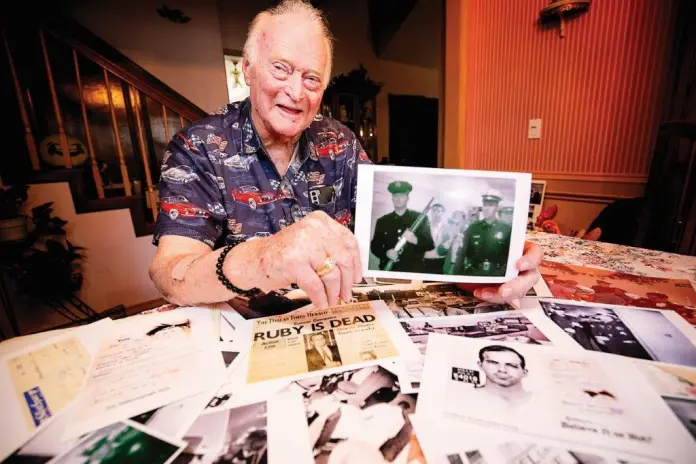Around the Flower Mound Senior Center, he’s known as the guy who runs the 50-50 drawings and plays poker three times a week. Six decades ago, he was a key figure in one of history’s most noteworthy days.
Weldon E. (Rusty) Robbins was a member of the Dallas Police Department the day President John F. Kennedy was killed by Lee Harvey Oswald. Already a six-year veteran of the force, the 6-foot-5 Robbins thought his only assignment would be controlling crowds on the 1800 block of Main Street a few blocks away from Dealey Plaza.
“It wasn’t a long parade, maybe 20 blocks long,” the now 88-year-old recalled at the Flower Mound home he’s shared with wife Ruth since 1994. “The crowds were filling up the sidewalks about noon.
“At that time we didn’t have as many shopping centers so people went to town to shop. That’s why downtown was crowded. And it was advertised a lot that Kennedy was coming down Main Street. So everybody went onto Main Street to watch the parade go by.
“Not any of the 100 or 200 people I could see did anything. I have to believe they saw me and knew not to mess with me. I felt good about my presence there.”
Figuring he was done for the day, he returned to his locker to change clothes but minutes later somebody came in and said Kennedy had been shot. He quickly put his uniform back on and reported to patrol headquarters for possible assignment. He then heard someone on the police radio say (policeman) J.D. Tippet had been shot.
He soon learned the person suspected of killing Tippet and Kennedy had run to the Texas Theater in Oak Cliff. That’s where a handful of police arrested Oswald watching “War is Hell.” In the meantime, Robbins went home.
Two days later and following normal protocols, Oswald was being transferred from the city jail to the county jail to await trial. Nightclub owner Jack Ruby – whom Robbins knew well – shot and killed Oswald while Robbins and the whole country watched live on television.
Robbins and fellow officer Sam Sorsby were then assigned to the Parkland Hospital morgue to guard the room where Oswald’s body was being held.
“They told me to grab two shotguns and meet Sam at Parkland,” Robbins said.
A famous photo taken by the former Dallas Times-Herald shows Robbins and Sorsby guarding the door. After about an hour, they were invited into the room to view Oswald’s body. Surrounded by about 10-15 photographers, Robbins and Sorsby escorted Oswald down the hall to a waiting ambulance to take him to a Fort Worth funeral home.
While that ended Robbins’ direct involvement, for years he talked about his experience in person at various places including four times at the Sixth Floor Museum plus on Zoom to school and other groups nationwide.
He will share some of his story again at Nov. 5 as part of the three-episode program “JFK: One Day in America” at 7 p.m. on the National Geographic Channel and available the next day on Disney+ and Hulu. He was interviewed for the show nearly a year ago.
Robbins grew up in Oak Cliff and after flunking out of college he took a construction job. He was 19 and eligible to be drafted for the Korean War.
“I didn’t want to go fight anybody. I was happy here at home,” he said. “I had a girlfriend or two or three. I was driving a ’49 convertible. That drove me to smoking because when I drove down the street I had to have a pipe in my mouth.”
Soon thereafter he was introduced to a policeman who was in the National Guard and told Robbins about what was called the Air Police. While he had never heard of such a unit, when he learned joining it would keep him from being drafted, he jumped at the chance. He also rode with the policeman he met and others.
“That ride-along convinced me I needed to be doing this full-time,” he said. “I liked it.”
As soon as he turned 21, he applied to become a Dallas police officer and his crew cut and blue suede shoes made popular by Elvis Presley caught the attention of his interviewers.
“I was a young man looking cool,” he said. “But apparently some of them didn’t think that. There was one in particular named Ed Preston, an inspector, who I was told would try to anger me in the interview. I was being watchful for that. Ed Preston took it upon himself to be the bad guy.”
Preston kept asking Robbins about his haircut and shoes but Robbins held his ground and despite Preston voting against him, he got the job.
He was initially assigned to an undercover unit focused on gambling and prostitution while he waited for the next rookie school. After graduating he served more than two years on patrol for the North Central Dallas precinct. That was followed by two years as what he called a motor jockey. After breaking his leg, he spent 6-8 months on office duty then returned to his motorcycle until staffing cuts moved him to Central Patrol where he also served as a backup report typist.
Robbins served 30 years with the Dallas Police before retiring at age 51 as a parking enforcement sergeant in 1986. He worked as a non-police public service officer in parking enforcement and directing traffic for nearly eight years then spent six years with the Texas State Lottery criminal investigation division before retiring for good at age 65.
“I had had enough,” he said. “I could draw three pensions – police department, traffic department and the lottery plus social security,” he said.
Today, he mostly can be found at home with Ruth whom he married in 1987, at doctors’ offices or the Senior Center.
“My life has been amazing,” he said.

















